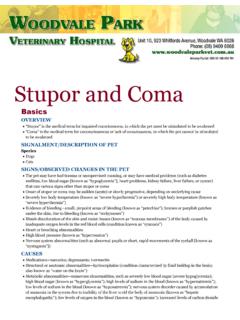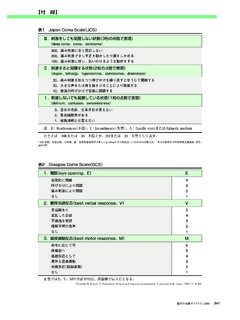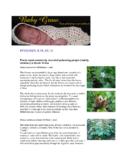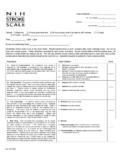Transcription of coma and brain death 2002 - ym.edu.tw
1 Coma and brain death Conscious be aware or sensible of an inward state or outward fact ( ) Consciousness ( ) state of beingconscious; awareness of the self and the environment ( ) Coma ( ) Consciousness disturbance(not conscious disturbance), Comatose (not comatous) Brainstem RAS (mid-pons rostrally) and its projections to the hemispheresAnatomic basis of coma (results from lesions that affect either the RAS or both hemispheres) (Arousal): 1. ( 2. 3. (Awareness) 1. 2. 3. Consciousness Disturbance( ) Arousal / Level: maintained wakefulness by intact ARAS and both cerebral hemispheres Lethargy, Drowsy, Obtundation, Stupor, and Coma Cognitive content.)
2 Sum of mental function, leading to awareness of self and environment and the expression of psychological functions of sensation, emotion and thought Confusion, Delirium, Psychosis, Illusion, Hallucination Coma Scale (Teasdale & Jennett, 1977) Eye Opening 4 - 1 Verbal Response 5 - 1 Motor Response 6 - 1 Eye OpeningSpontaneous 4To speech 3To pain 2 None 1 Verbal ResponseOrientated 5 Confused 4 Words 3 Sounds 2 None 1 Motor ResponseObeys commands 6 Localizing to pain 5 Withdrawal from pain 4 Flexion to pain 3 Extending to pain 2 None 1 (supratentorial).
3 20% (infratentorial) .. 13% (diffuse/metabolic) .. 65% (psychogenic) ( ) .. 2%> Plum and Posner (1980): 500 Causes of Consciousness DisturbanceHoward RS (1995): 40% drug ingestion 25% hypoxic-ischemic insult20% stroke ICH, basilar a. thrombosis 15% general medical disordersGoal of in Consciousness Disturbance To establish the existence of clinicaldiagnosis of coma To localize the neurologic lesion To provide clues about underlying causeNeurologic Examination in Consciousness Disturbance Vital sings (TPR) and Skin before Level of consciousness: GCS Respiratory patterns: Cheyne-Stokes, hyperventilation, apneustic , ataxic Brainstem reflexes.
4 Pupils, corneal reflex, reflex eye movements Motor and reflex signs MeningismAbnormal respiratory patterns associated with pathologic lesions at various levels of the brainMajor brainstem reflexes used in the coma examinationPupils in comatose patientsBrainstem pathways mediating conjugate horizontal eye movementsCaloric Test for Vestibular Function (30-100 cc ice water for oculovestibular reflexes in comatose patients)Oculocephalic and Oculovestibular reflexes in comatose patients with:(1) brainstem intact(doll head eyephenomenon)(2) bil. MLF involvement(3) and low brainstem lesionInternuclear Ophthalmoplegia (left MLF lesion)Looking forwardLooking to leftLooking to rightConvergenceMotor responses to noxious stimulation in acute cerebral = Rt hemisphereB = DiencephalonC = Midbrain/PonsD = MedullaMeningeal Signs: Neck stiffness, Brudzinski signKernig Sign: Meningism or Lumbar Disc HerniationLumbar Puncture (CSF Exam):Meningitis or Subarachnoid Hemorrhage (SAH)Probable Causes of Coma by brain stem intact:(-)lateralizing sign & (-)meningism Diffuse,metabolic, toxic encephalopathy ( )lateralizing sign & (+)meningism Meningitis,SAH(+)lateralizing sign & (-) meningism Supratentorial lesions brain stem dysfunction.
5 Infratentorial lesion (brainstem or cerebellar)Herniation supratentorial ARAS Supratentorial Mass with brain Herniation1. Cingulate (subfalcine)herniation2. Transtentorial (central) herniation3. Uncal herniation: uncus edge of tentorium III & cerebral peduncle4. Tonsillar herniationUncal Herniation: coma with ipsilateral oculomotor palsy and contralateral hemiplegiaNeurologic signs in coma with downward transtentorial herniation ( ) brain Stem Reflexes (bizarre) hyperventilation,apneustic,ataxic / (Diffuse/Metabolic Encephalopathy asterixis, myoclonus, tremor, seizures etc.)
6 Hyperventilation hypoventilation - Psychogenic Babinski sign Assessment and Management of Acute Coma 1. Stabilization Airway control Oxygenation and ventilation Adequate circulation (includes avoidance of hypotension in stroke) Cervical stabilization head injury or cervical trauma, RAAssessment and Management of Acute Coma - 2. Coma Cocktail Thiamine 100mg IV Dextrose 50% 50 ml IV (may held if immediate fingerstick glucose available) Naloxone IV or Flumazenil (Anexate) IV Obtain blood for CBC, PT, PTT, chemistry panel, toxic screen, blood culturesAssessment and Management of Acute Coma - 3.
7 Threatening Conditions Elevated ICP head CT Meningitis, encephalitis LP, blood cultures Myocardial infarction EKG Hypertensive encephalopathy early therapy Status epilepticus EEG Acute stroke consider thrombolytic therapyOutcome from Coma Not possible to assess the prognosis with complete accuracy Coma by drug ingestion good prognosis Traumatic coma > similar level of coma from nontraumatic causes Prognostic factors in nontraumatic coma: etiology, depth & duration of comaAssessment and Management of Consciousness Disturbance Early Therapy for Threatening Conditions To Prevent or Diminish Disability and Mortality brain death 1968 Ad Hoc Committee of the Harvard Medical School: brain death 1971, Mohandas & Chou: brainstem death 1976.
8 Awareness Total brain DeathCerebral death Vegetative StateVegetative State Be awake, eyes opening, but no awareness of self or environment, Unable to interact with others No sustained, reproducible, purposeful or voluntary behavioral responses Breathing spontaneously, normal brainstem reflexes Inconsistent nonpurposive movementsPersistent Vegetative State (PVS)American Multi-Society Task Force PVS: Vegetative state has continued for at least one month, but not imply permanency or irreversibility Outcome of PVS: age, etiology, duration 12 months after traumatic injury, 3 months after nontraumatic insult PVS be permanentBrainstem death is brain DeathBrainstem Reflexes for Coma (>12hrs)











